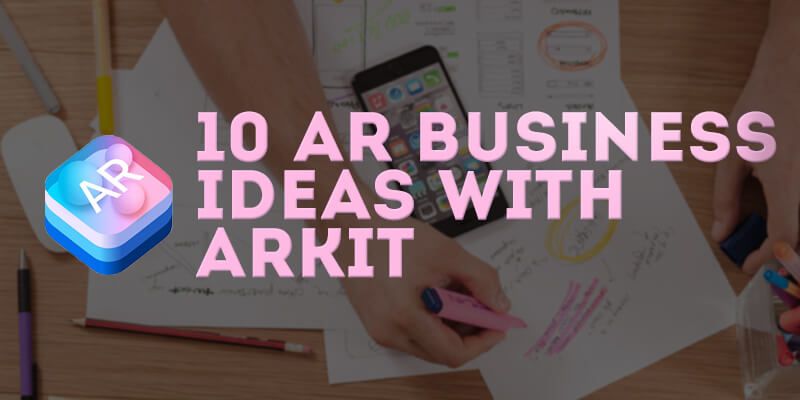Apple’s long-awaited entry into AR became a reality when Apple revealed its AR development platform ARKit, at the 2017 World Wide Developer’s Conference.
Described by Craig Federighi, Apple’s Senior Vice President of Software Engineering, as “the largest AR platform in the world,” ARKit comes with high expectations. Coupled with Apple’s newest mobile operating system, iOS 11, ARKit opens the door to new and exciting business ideas for augmented reality.
With the augmented reality market projected to reach $100 billion by 2024, now is the time for investors and innovators to capitalize on the AR platform Apple has provided. The power of ARKit pushes AR development to entirely new levels, enabling app companies to create augmented reality apps that entertain and empower us as never before.
10 Business Uses for ARKit Applications
Here are just a few of the augmented reality business uses ARKit allows offers for applications designed for the iPhone and iPad:
- the ability to identify horizontal and vertical planes within the room
- precise tracking of device orientation
- virtual object illumination based on ambient lighting
- creation of highly-detailed virtual content
- virtual object auto-sizing
- interactivity between virtual objects
ARKit interfaces with development platforms such as Unreal, Unity, and others, providing easy entry into the emerging AR market. Combined with existing 3D mapping applications, such as Occipital, the possibilities are limitless.
As with any new and powerful tool, it is impossible to say how ARKit will be used. However, we have compiled a list of ten possible business uses, each with the potential to launch new businesses, while disrupting existing ones.
1. 3D Databases
The concept of multidimensional databases has been around for awhile. Used primarily for analysis of complex business data, multidimensional databases allow data to be stored, accessed, and analyzed across multiple dimensions, as opposed to the typical tabular database that presents data only in vertical columns and horizontal rows.
Using Visual Inertial Odometry (VIO), ARKit can power databases that store data within a cube structure. Envision, if you will, an app that displays a simple two-dimensional calendar. With your iPhone or iPad oriented vertically, you can move horizontally and vertically to select any day of the month. Then, you can move the device forward to access notes you have stored for that day.
Essentially, 3D databases allow you store data in three dimensions, and to access that data by moving your Apple device within the data cube. Targeted data can be easily selected for use in standard apps.
Applications for this technology include:
- 3D calendars
- true-3D spreadsheets
- 3D SpringBoards
- 3D storage of music, video, and images
The business potential of making multi-layers of data accessible through an interactive, visual interface is enormous. No doubt, many developers are already moving their iPhones about in the air as they contemplate the possibilities.
2. AR Dating Services
According to recent statistics, online dating is responsible one-fifth of committed relationships and 17% of marriages. That’s the good news. The bad news is that in order to use an online dating service, you have to be…well, online.
The Apple AR platform can redefine online dating by combining a few features of ARKit, along with traditional smartphone technologies such as these:
- geolocation
- ARKit’s VIO capability, discussed earlier
- SaaS cloud-based platforms

Rather than flipping through one online profile after another, AR dating services can enable users to locate other dating service members by scanning crowds with their mobile device and seeing fellow members circled or otherwise identified within the image. Wherever large numbers of people gather, one could spot fellow singles meeting their search criteria, and even retrieve their profiles.
Augmented reality provides an entirely new way to find companionship, and opens new opportunities for dating services to expand the playing field.
3. Construction Site Management
AR has already found a few applications in the construction industry, helping project developers to visualize buildings in 3D. The new Apple AR platform promises to offer a great deal more and promises new AR business opportunities in this lucrative market.
Using anchors and tracking features, project developers and engineers can scan the construction site with an iPad and see selected layers of data superimposed over the construction area. Here are a just few examples of how the technology can be used:
- plumbing and electrical lines will appear where they will be placed or have been buried
- accurate measurements can be made using only an Apple mobile device
- construction can be visualized at various levels of completion according to dates selected
ARKit allows development of applications with improved detail and accuracy, and which update the screen in real time as the device scans the project site.
4. Moving/Freight
ARKit is already being used to create apps for taking room measurements. However, the technology does not end there. One of the most exciting augmented reality business ideas made possible by ARKit includes making the moving and freight industry more efficient and, therefore, more profitable.
Using the ability of ARKit to identify horizontal and vertical planes, and to take measurements, an iPhone or iPad can be used to scan home furnishings that are to be moved by moving van. Software can then calculate the order to load each item into the moving van, and the proper orientation, to maximize use of space. The process might be as follows:
- measure furniture items and store dimensions for processing
- measure moving van interior dimensions
- calculate proper placement of furniture items inside van
- AR overlays data showing which item to load in what order and how it should be oriented
Movers of home furnishings and commercial freight handlers can both work more efficiently using ARKit’s powerful features.
5. Sports Apps
Sports fans are all about data. Who holds the record for the longest goal in soccer? Which NFL player made the longest pass of the season? Which baseball player has the fastest pitch? Using ARKit’s object motion tracking capabilities, fans can view a ball game through their mobile device and see important data that has overlayed the players and the playing field.
Here are just a few ways AR, when coupled with big data, can keep fans informed during the game:
- ball speed could be calculated as a factor of distance and time and displayed on the screen, along with previous records
- the distance a ball is moved could be calculated and displayed
- broadcast services could stream real-time game data to their sports apps that fans have downloaded onto their Apple devices
AR may not catch on immediately, as sports fans are not typically open to new-fangled ideas. Even so, the sooner AR innovators get in the game, the sooner AR will give fans another reason to cheer.
6. Painting Apps
Entire businesses have been built on single apps, and this one provides just such an opportunity. ARKit empowers apps to capture accurate room measurements. Combined with a bit of materials cost information from the cloud and you have an app that allows painters to quote jobs faster and more accurately.
Incorporating ARKit features into app design can add powerful features, such as these, to contractor apps:
- accurate square-foot calculations simply by scanning the room with their Apple device
- fast cost calculations
- allowing the client to see the room as it would be painted in their chosen color
Yep, you could build a business on that.
7. AR Landscaping
A few — and we do mean a few — companies have already discovered the value of incorporating AR technology into landscape design software. Even so, ARKit may very well change that by supercharging landscape design applications with features like these:
- fast and easy landscape measurements using Apple devices
- automatic cost calculations using measurement data
- the ability to allow clients to “walk” through a 3D model of the proposed landscape design
Companies that move into the landscaping app market with technology built upon ARKit have the yard to themselves. For the moment, at least.
8. Building Maintenance
Building maintenance apps enable maintenance directors to perform billing, scheduling, and other project management functions easily. Unfortunately, they do little to help maintenance personnel perform their jobs. ARKit’s feature set can be used to build apps that equip maintenance personnel with the following capabilities using their Apple devices:
- locating cable runs, ductwork, and water pipes located inside walls and ceilings
- viewing maintenance instructions overlaid on top of equipment
- locating specific riser rooms, elevator rooms, electrical rooms, and telephone rooms within a 3D model of the building
Of course, in order for AR overlay data to be retrieved, it must first be created and stored, presenting further augmented reality business opportunities.
9. Hiking Safety
Another business opportunity exists in developing apps for hikers. With hundreds of persons missing in U.S. national parks, alone, the time has come to leverage technology to keep hikers on the right path.

AR Business Ideas - Hiking apps.
Source: Peakvisor.com
Utilizing geolocation, along with ARKit’s VIO feature, products can now be easily developed that track hikers’ movements and guide them back to base using the same path they traveled away from it. Such apps might include features such as these:
- AR map guidance to keep hikers on safe trails
- AR warnings to alert hikers when entering dangerous areas
- storage of paths taken for use on later visits
Personal safety is big business, and with Apple’s new AR framework, it might just get a lot bigger.
10. Friend Finder
Social media has become an integral part of life for billions of people around the world, with the most popular platforms being those that let people interact in real time. ARKit’s ability to precisely track device location and orientation opens social media business opportunities that capitalize on these new features. As ARKit becomes the de facto AR platform Apple hopes it to be, we will see more social media apps that tap its power.
One example of such an app could make users aware when friends are in their vicinity. Whether at a sporting event, shopping mall, or university, geolocation and AR technology can enable friend-finder apps to detect the presence of persons on the user’s friends list, and display where they are located within the crowd.
Of course, some additional wizardry might be necessary to create a commercial-grade platform. Additional requirements for a viable business-worthy application could include:
- cloud hosting of friends lists
- cloud-based user platforms
- cloud-based integration with existing social media platforms
And all those cloud services provide yet another opportunity for businesses to capture.
Why AppReal-VR?
Not every idea presented in this article will spawn successful startups in the near future, but many will do just that. Combined with cloud-based platforms and other technologies, the ideas we have proposed will seed new businesses while disrupting existing ones. One thing is certain: augmented reality and business will do a lot of hand-shaking in the months to come.
The main idea we hope we have conveyed is that Apple’s new ARKit framework makes possible what was previously impossible — and that has been the foundation for successful businesses throughout history. But new technology by itself is useless, unless you know how to use it.
That is where AppReal-VR comes in.
We harness the power of cutting-edge technologies to provide outsource solutions to companies around the world. With six R&D labs across Eastern Europe, and some of the best developers in the world on our team, we stand ready to bring your ARKit project to reality and to market. Why not contact us for a free consultation, today?


I like the idea of geolocation apps, the ways to implement them in startups are numerous. And the pricing is not too big https://applikeysolutions.com/blog/how-to-create-a-mobile-app-with-geolocation